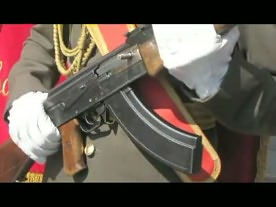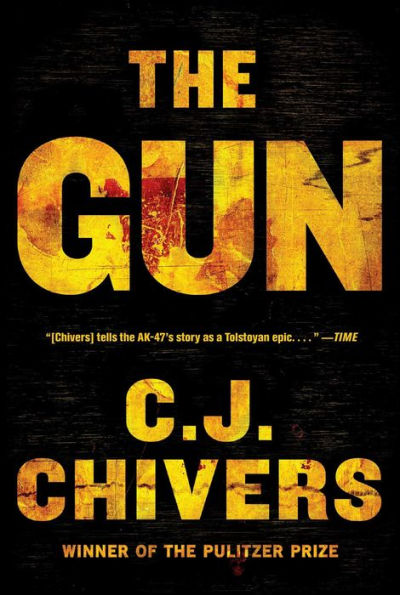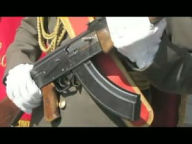

eBook
Related collections and offers
Overview
At a secret arms-design contest in Stalin’s Soviet Union, army technicians submitted a stubby rifle with a curved magazine. Dubbed the AK-47, it was selected as the Eastern Bloc’s standard arm. Scoffed at in the Pentagon as crude and unimpressive, it was in fact a breakthrough—a compact automatic that could be mastered by almost anyone, last decades in the field, and would rarely jam. Manufactured by tens of millions in planned economies, it became first an instrument of repression and then the most lethal weapon of the Cold War. Soon it was in the hands of terrorists.
In a searing examination of modern conflict and official folly, C. J. Chivers mixes meticulous historical research, investigative reporting, and battlefield reportage to illuminate the origins of the world’s most abundant firearm and the consequences of its spread. The result, a tour de force of history and storytelling, sweeps through the miniaturization and distribution of automatic firepower, and puts an iconic object in fuller context than ever before.
The Gun dismantles myths as it moves from the naïve optimism of the Industrial Revolution through the treacherous milieu of the Soviet Union to the inside records of the Taliban. Chivers tells of the 19th-century inventor in Indianapolis who designs a Civil War killing machine, insisting that more-efficient slaughter will save lives. A German attaché who observes British machine guns killing Islamic warriors along the Nile advises his government to amass the weapons that would later flatten British ranks in World War I. In communist Hungary, a locksmith acquires an AK-47 to help wrest his country from the Kremlin’s yoke, beginning a journey to the gallows. The Pentagon suppresses the results of firing tests on severed human heads that might have prevented faulty rifles from being rushed to G.I.s in Vietnam. In Africa, a millennial madman arms abducted children and turns them on their neighbors, setting his country ablaze. Neither pro-gun nor anti-gun, The Gun builds to a terrifying sequence, in which a young man who confronts a trio of assassins is shattered by 23 bullets at close range. The man survives to ask questions that Chivers examines with rigor and flair.
Throughout, The Gun animates unforgettable characters—inventors, salesmen, heroes, megalomaniacs, racists, dictators, gunrunners, terrorists, child soldiers, government careerists, and fools. Drawing from years of research, interviews, and from declassified records revealed for the first time, he presents a richly human account of an evolution in the very experience of war.

Product Details
| ISBN-13: | 9781439196533 |
|---|---|
| Publisher: | Simon & Schuster |
| Publication date: | 10/12/2010 |
| Sold by: | SIMON & SCHUSTER |
| Format: | eBook |
| Pages: | 496 |
| File size: | 23 MB |
| Note: | This product may take a few minutes to download. |
About the Author
What People are Saying About This
"Eye-opening.... An entertaining work that combines technical details, biographies, political maneuvering and insightful military history." —-Kirkus
Interviews
A Conversation with
C. J. Chivers,
Author of THE GUN
What led you to write this book?
In late 2001, David Rohde (a fellow reporter at The New York Times) and I found large collections of Taliban and al Qaeda records in several abandoned insurgent training camps in Afghanistan. Separately, in different provinces and areas of Afghanistan, we gathered up these materials and carried them out. We worked with a small bank of translators to bring them into English, and developed, from the notebooks of jihadi recruits and their instructors, a sense of how these fighters were trained. One element jumped out at me: at every camp, no matter the language or the terrorist group that gave the class, no matter the location of the camp, lesson one was a primer on the automatic Kalashnikov.
That began a long inquiry into these weapons: why were they everywhere there is fighting? How did they become so abundant and widespread? What about them made them a principal instrument of violence in our time? Nine years later, I'm coming up for air.
What role did your experiences as a war reporter and an infantry officer in the U.S. Marines play?
Obviously it informed my work at most every step. The research was based on the idea that to understand the Kalashnikov, you need to put into a much fuller and richer historical perspective than the easy conventional wisdom that has surrounded it. This meant going back almost a century before the Kalashnikov appeared, and tracing the evolution of rapid-fire arms and how they influenced tactics and the experience of war. My years as a Marine Corps infantry officer left me with a firm understanding of ground tactics and the roles, limitations and risks of many different weapons. The corps also places a premium on studying military history, so I had packed a lot of background in my head already, and drew from it as I plunged in with more intensity and focus. And my years covering war, crime, terror and human rights had enriched all of this, and gave me access to conflicts in a very personal, up-close way. The scores and scores of patrols—and the access to fighters of all sorts, and insurgents and child soldiers, and medical workers and victims of violence—richly informed the book, which is not based on just archival work or interviews or analysis, but also on material and insights from the field. And being a former Marine, and, at the basic sense, a grunt, helped with access, too. All sort of fighters, not just in Western military circles, but among guerillas and insurgents, too, sensed I had more than a basic understanding of weapons and tactics. Many of them found our meetings and conversations very engaging, and this led to a willingness to cooperate and more sharing of material.
What is so special about the AK-47? What is it able to do better than other guns? Is its performance really as good as legend claims?
The automatic Kalashnikov has many remarkable traits; but no, it is not the miracle weapon that it is often described to be. It is the result of a set of design compromises, and in compromise is imperfection, and limitation. That said, its compact size, its ease of use, the simplicity and sturdiness of its design, and the high quality of its protective finishes make it a weapon that almost anyone can use in most any circumstances. I remember when I first was shown one up close, as a young Marine, and an instructor held one up and said: "This is a bullet hose." It's an apt description. But I would argue that its most important trait is not in the characteristics of each rifle, but in the line's abundance and the circumstances of its spread. If there weren't so many of them, they would be a much less influential object, and somewhat less interesting, although they certainly are interesting in their own right.
What is the myth of the invention of the AK-47? How much truth is there in it?
The simple fable is that the AK-47 resulted from the epiphany and determination of an unlettered sergeant who had been wounded in the Great Patriotic War. The truth is much, much more complicated, and the weapon is better understood as the result of Soviet administration in the Stalin years, and the investment of extraordinary amounts of resources. The Kalashnikov was the product of the Soviet state. Examining it this way is useful, because its design and its abundance tell us something of the priorities of the Soviet Union. Remember, this was a system that could not make, or did not care to make, a decent toilet or refrigerator or pacemaker. But the guns? These were a priority, and they were exceptionally well-considered and matched to what the Soviet Army wanted them to do. The idea that the AK-47 sprang from one man's mind is proletarian myth. It was the result of collective work at a grand scale.
How did the AK-47 become the defining weapon of the Cold War? How was its destiny linked to the atomic bomb?
These two weapons were designed simultaneously in the earliest moments of the Cold War. They both flowed from the Soviet Union's aggressive and successful intelligence work, and are conceptual copies of weapons that the Soviet Union's enemies had developed first, and that had caused alarm and worry. In 1949, when the Kremlin's first atomic bomb was exploded on a tower on the Kazakh steppe, the first production of the AK-47 was secretly rolling off the assembly lines in a massive plant in the Urals. And from there the two weapons, a mismatched pair, worked in concert. The atomic bomb and its many descendants helped freeze borders in place, and cleared the way for the means by which the Cold War would largely be fought—in proxy wars and influence scrums around the world. And for these wars, the AK-47 was very well suited. As production increased and its reputation and availability spread, it became the most common instrument of modern war, and part of the Soviet Union's real legacy.
How did you research this book?
The book covers a large swath of history and geography, and delves into current affairs, too. So it required many different approaches. I scoured archives in the United States and abroad for historical materials, and spent many a night reading the diaries and letters and memoirs of soldiers and inventors long deceased. I chased after out-of-print books that might shed insights into particular questions: how did the Sudanese fight at Omdurman? When and how were machine guns first used? I toured museum collections, met with curators and specialists and government arms-design and ordnance officials to build an understanding of how weapons are made, and how they work. I dug up ballistics studies, old and new, and sometimes fought for their public release. I chased after internal reports of arms manufacturers. As the narrative became more recent, I tracked down and interviewed veterans and arms officials involved in important events in the book—including particular battles in Vietnam. I went and stood at the test site where the first Soviet atomic bomb was detonated, and saw the damage, and then absorbed the information available from the test site's caretakers and historian. And of course I did extensive field work, walking scores and scores of foot patrols in Afghanistan and Iraq, and sitting in on rifle training and interviewing participants. It was an obsession, I suppose—passing a long period (when I should have been on vacation) at Beslan, where I had worked as a correspondent during the worst terrorist siege of our time, and unraveling the roles of weapons; or, another vacation spent in Acholiland, in Uganda, interviewing child soldiers and their victims, and gaining a firm understanding of how a millennial movement had been armed. The work on the ground, in the wars and at terrorist acts, in hospitals, at graveyards, with criminal investigators, was essential. It's not so hard to appreciate what these weapons are, and how they shape fighting, if you have been ambushed by people carrying them. Unfortunately, that has happened to me too many times. The book drew together all of these sources and means of research, and many others, and each served its purpose well. I can't imagine the book without all of them. It would be much less sturdy.
What do you hope readers take away from it?
Readers will quickly see that THE GUN is not focused solely on weapons, although there is a lot of material—some of it never seen before—on weapons and their development and what they do. The book is focused on people. It was researched and written in part as social history. And so what is here are stories, one after another, of people and their relationship to weapons and to war across almost 150 years of war: callous officers on colonial duty in Africa; young "volunteers" in the trenches of the Western front; intensely competitive businessmen and inventors who suspended ethics or good sense as they sought markets; Marines in Vietnam who found that they faced Kalashnikovs with weapons that did not work; child soldiers who recount their duties caching Kalashnikovs in the African soil and then returning years later to retrieve and restore them. The weapon becomes a lens to examine people—personally, in the context of their governments or their businesses or their laboratories, and as combatants or victims or salesmen. In these stories, weaved together, are a means to understand how we came to a time when the Kalashnikov became the world's dominant firearm, and how the combination of its peculiar characteristics and its ready availability has shaped war in the past decades, and to this day. When you get done with this book, I hope you will have a stronger sense of what war is, and of what weapons are, and who is behind them. But what do I want readers to take away? I want them to take away the stories that make it possible to understand these themes. We turn to books for stories, not just for information. And that's what's here: stories, each of which can stand on its own, but all of which point to the place of the Kalashnikov in modern war, and how we got to where we are.
The Kalashnikov is many, many things. It's also a hell of a story.
Related Subjects
Videos


